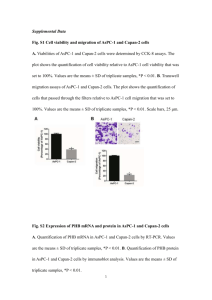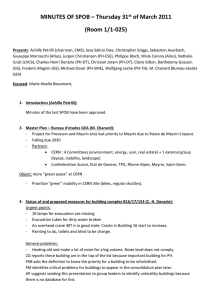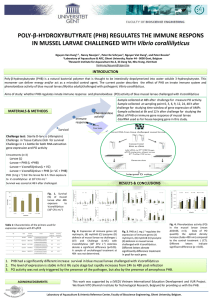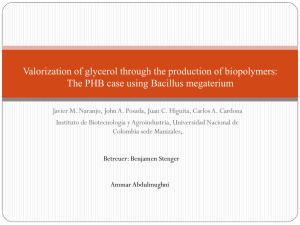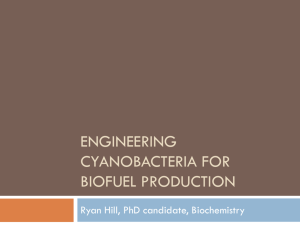Economic and cradle-to-gate life cycle assessment of
advertisement
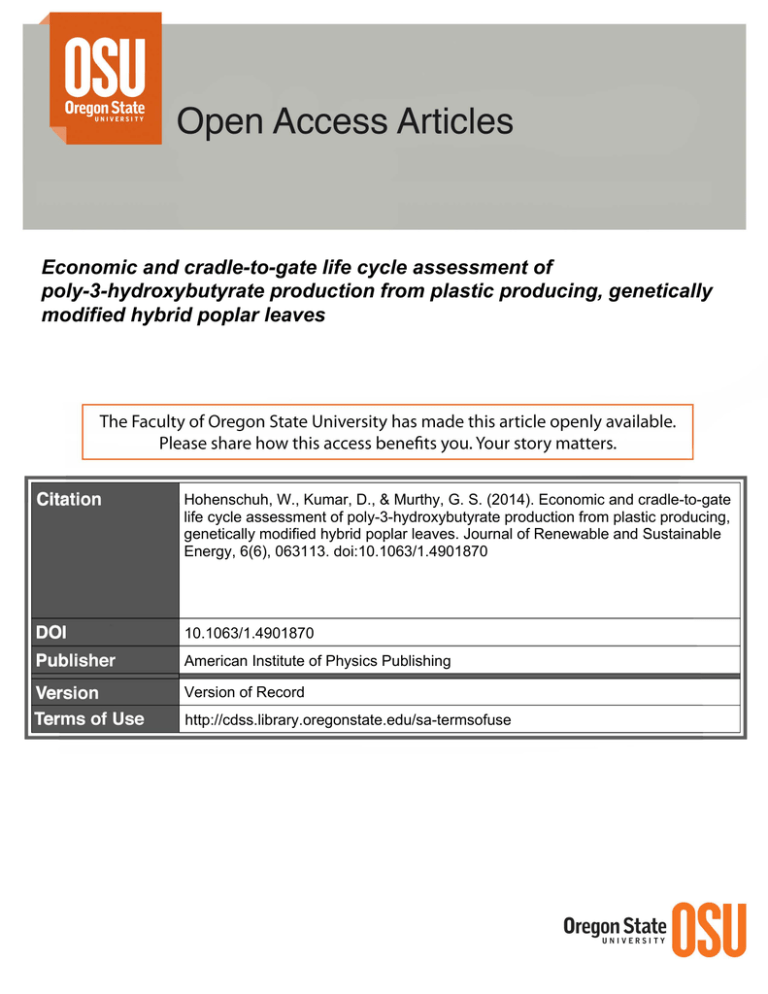
Economic and cradle-to-gate life cycle assessment of poly-3-hydroxybutyrate production from plastic producing, genetically modified hybrid poplar leaves Hohenschuh, W., Kumar, D., & Murthy, G. S. (2014). Economic and cradle-to-gate life cycle assessment of poly-3-hydroxybutyrate production from plastic producing, genetically modified hybrid poplar leaves. Journal of Renewable and Sustainable Energy, 6(6), 063113. doi:10.1063/1.4901870 10.1063/1.4901870 American Institute of Physics Publishing Version of Record http://cdss.library.oregonstate.edu/sa-termsofuse JOURNAL OF RENEWABLE AND SUSTAINABLE ENERGY 6, 063113 (2014) Economic and cradle-to-gate life cycle assessment of poly-3-hydroxybutyrate production from plastic producing, genetically modified hybrid poplar leaves William Hohenschuh, Deepak Kumar, and Ganti S. Murthy Biological and Ecological Engineering Department, Oregon State University, Corvallis, Oregon 97331, USA (Received 5 June 2014; accepted 31 October 2014; published online 20 November 2014) Poly-3-hydroxybutyrate (PHB) is a renewable, biodegradable biopolymer that has shown great promise to offset the use of hydrocarbon-derived plastics. The genes encoding the bacterial PHB production pathway have been engineered into several higher order plant species providing an opportunity to produce PHB as a co-product on an industrial, agricultural scale. This study investigates the economic feasibility and estimates the life-cycle greenhouse gas (GHG) emissions produced during the PHB production from hybrid poplar leaves. An established, bench scale extraction procedure was extrapolated upon using SuperPro designer to estimate the product cost, raw materials and energy used during extraction of PHB from poplar leaves on an industrial scale. Assuming an economically feasible concentration of PHB could be produced in the leaf material, a cradle-to-gate life cycle assessment was performed under two of the most likely poplar production scenarios for the Northwest United States where poplar is commonly grown for biomass applications. The cost of PHB production was found to vary greatly with the PHB content in the leaves; from $33.28 per kg at 0.5% PHB to $1.72 per kg at 20% PHB content. Poplar production scenarios varied greatly in their emission of GHGs. An irrigated poplar production scenario is estimated to produce 248.8% more GHGs than production of the displaced polypropylene. An un-irrigated poplar production scenario produced 76.1% less GHGs. Both production scenarios produced significant amounts of volatile organic compounds (VOCs) associated with normal poplar growth that could prove detrimental to local air quality. PHB content of 15% in the poplar was required to bring the PHB production price to $2.26 per kg and make production competitive with petroleum-derived plastics. C 2014 AIP Publishing LLC. [http://dx.doi.org/10.1063/1.4901870] V I. INTRODUCTION In 2011, about 280 106 tons of plastics were produced globally, most of which (about 99%) is derived petro-chemically.1 Rising concerns over the sustainability of, and pollution created by petroleum-derived plastics are driving research on renewable, bio-based plastics. The diverse properties of bio-plastics are such that they could be substituted in 90% of current plastic applications.2 Poly-3-hydroxybutyrate (PHB) is one such bio-plastic with the potential to compete favorably with petroleum-derived plastics.3,4 It is a member of the polyhydroxyalkanoate (PHA) family, a group of non-toxic biodegradable polyester polymers produced by microorganisms as carbon and energy reserves.5–7 PHB has a particularly high potential for industrial applications because of its high crystallinity, resistance to hydrolytic degradation, and similar physical attributes as polypropylene (PP).8 PHB is the most commonly produced PHA in microorganisms. Bacterial PHB concentrations have been found to be as high as 87% dry cell weight when grown heterotrophically on sugars and organic acids,9 but the cost associated with PHB production in monoclonal bacterial cultures has shifted much of the attention to production of PHB in plants. Since 1992 the PHB 1941-7012/2014/6(6)/063113/12/$30.00 6, 063113-1 C 2014 AIP Publishing LLC V This article is copyrighted as indicated in the article. Reuse of AIP content is subject to the terms at: http://scitation.aip.org/termsconditions. Downloaded to IP: 128.174.160.65 On: Wed, 04 Feb 2015 14:34:22 063113-2 Hohenschuh, Kumar, and Murthy J. Renewable Sustainable Energy 6, 063113 (2014) biosynthesis pathway has been expressed in several plant species including Populus trichocarpa, Arabidopsis thaliana,10,11 Medicago sativa (alfalfa),12 and Saccharum spp. Hybrids (sugarcane).7,13 While production in plants could prove advantageous in the long run, current yields are far below those found in bacterial cultures. For example, yields in transgenic alfalfa have been reported at just 2.5 103 to 0.18% w/w on a dry weight basis.12 Sugarcane yields have been reported at up to 4.8% w/w7,13 and transgenic Arabidopsis has shown potential to produce up to 40% yield.10 However, a very high accumulation of PHB in transgenic Arabidopsis produced stunted plants with sever metabolic and developmental defects. Recent work has shown that the PHB biosynthesis pathway can be expressed in the leaves of hybrid poplars.14 Hybrid poplar (Populus spp.) is among the fast growing hardwood species and is commercially grown for wood and pulp production and as a feedstock for the production of liquid transportation fuels. Farmed poplar stands reach a harvest size in 3–5 yr.15 The production of a value added co-product during its growth phase could help to offset wood production costs and make poplar a more attractive investment to farmers. Poplars are deciduous trees and shed their leaves annually providing an opportunity to collect the leaves and extract the PHB as a saleable co-product. After extraction of PHB, the residual leaf matter could be returned to the land as a soil amendment. The objective of this study was to perform an integrated techno-economic and life cycle assessment of PHB production from genetically modified (GM) poplar leaves. As with any emergent technology, techno-economic feasibility, sustainability, and environmental impact are critical concerns. There is currently no commercial facility for production of PHB from plant materials. This is mainly due to the absence of an economically viable feedstock that combines low cost, fast growth, and high PHB yield. While a viable substrate is still in development, the component technologies for extraction are available and a bench top process for PHB extraction from poplar leaves has been designed.16,17 By modeling this process and scaling it to handle one ton of leaf material per hour we can estimate the production cost and determine the minimum PHB content required to make poplar derived PHB economically competitive with conventional plastics. Life cycle analysis, also known as life cycle assessment or LCA, is widely regarded as an appropriate methodology to estimate for potential environmental impacts from a product or process. A cradle-to-gate LCA is an assessment of the partial product life cycle that covers from the harvesting of raw materials to when the finished product leaves the factory. It does not include distribution, consumer use, or disposal. Beyond providing a baseline greenhouse gas (GHG) emissions range expected in PHB production this LCA will allow for direct comparison with cradle-to-gate LCAs completed for conventional and other bio-plastics. The specific objectives of this work are therefore to (1) estimate the minimum PHB content required in hybrid poplar leaves for economically competitive production of PHB, (2) establish baseline sustainability and environmental impact metrics for PHB production from hybrid poplar, and (3) compare the PHB production life cycle assessment results for three poplar production scenarios. II. METHODOLOGY The analysis was focused on a hypothetical plantation of genetically modified hybrid poplar containing PHB production genes. The hybrid poplar plantation was assumed to produce wood for bioenergy/bioproducts as the main product while providing an annual co-product of leaves to be harvested and processed for PHB production. A schematic of major process inputs and activities is shown in Figure 1. A. Techno economic analysis 1. Process model description The PHB extraction and granule production process from plant leaves was modeled in SuperPro designer (Intelligen, Inc., Scotch Plains, NJ) for a plant with a processing capacity of one ton of poplar leaf matter per hour (7920 tons/yr) (Fig. 2). A hybrid poplar plantation with This article is copyrighted as indicated in the article. Reuse of AIP content is subject to the terms at: http://scitation.aip.org/termsconditions. Downloaded to IP: 128.174.160.65 On: Wed, 04 Feb 2015 14:34:22 063113-3 Hohenschuh, Kumar, and Murthy J. Renewable Sustainable Energy 6, 063113 (2014) FIG. 1. Major process inputs and activities as well as the defined RMEE system boundary. 24 192–26 900 acres under poplar production would be needed to support such a plant and the estimated production of PHB would range from 39.6 tons at 0.5% PHB w/w leaves to 1584 tons/yr 20% PHB w/w leaves. The model was developed based on the PHB extraction protocol developed earlier by our group.17 The process consisted of four major processing sections: FIG. 2. The SuperPro model used during economic analysis and to predict energy and materials inputs for the LCA. This article is copyrighted as indicated in the article. Reuse of AIP content is subject to the terms at: http://scitation.aip.org/termsconditions. Downloaded to IP: 128.174.160.65 On: Wed, 04 Feb 2015 14:34:22 063113-4 Hohenschuh, Kumar, and Murthy J. Renewable Sustainable Energy 6, 063113 (2014) front-end operations, chlorophyll removal, PHB extraction, downstream processing (product recovery and waste/recycling management). The details and major assumptions made for these processes are discussed below. The model was designed to maximize energy efficiency and minimize the loss of volatile solvents. a. Front-end operations and chlorophyll removal. The leaves are cleaned of debris (dirt, rocks, and pieces of metal) in the first stage of processing. The size of the cleaned poplar leaves is reduced using a knife mill to facilitate extraction. After cleaning and size reduction, chlorophyll is removed from the poplar leaves. Chlorophyll, a photosynthetic pigment in the leaf material, is highly soluble in ethanol while PHB is insoluble in ethanol. Chlorophyll removal was modeled to be accomplished through ethanol (98% purity) extraction of the ground poplar leaves at 65 C for 2 h with a 10:1 solvent-to-solids ratio. The chlorophyll enriched ethanol stream is directed to an evaporator for recovery and recycle of ethanol and concentration of the chlorophyll. Residual ethanol is removed by flash evaporation to produce chlorophyll granules to be sold as a co-product. The ethanol stream produced in this process contains a small amount of water (5%) and was recycled back with pure ethanol for use in the chlorophyll removal process. A small fraction (0.75%) of the ethanol stream is removed as impure solvents while residual ethanol in the main stream (leaf matter) was recovered by flash evaporation at 85 C. The leaf material is directed to the secondary extraction process for PHB extraction. b. PHB extraction. This process utilizes the high solubility of PHB in chloroform to accomplish PHB extraction. In the process model, the chlorophyll free leaf matter was modeled to be transported via screw conveyor to a tank and is mixed with pure chloroform to achieve 10:1 solvent-to-solids ratio. The mixture is kept for 3 h at temperature of 55 C for complete extraction of PHB from the leaf material. The remaining leaf matter is separated from the PHB rich chloroform stream in a series of distillation and flash evaporation steps. The remaining leaf material (78.3% of the original leaf matter) is sold back to the farmer for use as a nitrogen source for soil amendment. c. Downstream operations. The impure solvents (ethanol and chloroform) removed during chlorophyll and PHB extraction are combined and were assumed to be sold as another coproduct for re-distillation into pure ethanol and chloroform. The chloroform stream from secondary is directed to thin film evaporator to concentrate the PHB and recover chloroform. The PHB granules are produced by removing almost all (99.9%) chloroform in the spray drier from the bottom stream of evaporator. About 99% of the chloroform is recovered using series of evaporations, flashing, and condensation processes, while about 1% of chloroform is directed to the aforementioned impure solvents tank, where it is mixed with the impure ethanol to be sold as a re-distillable co-product. Small amounts of solvent exhausts are produced throughout the process and are captured by an oxidative catalyst to reduce direct VOC emissions. 2. Assumptions for economic analysis Year 2012 was used as the basis for all economic calculations. The price of poplar leaf matter was assumed as $25 per metric ton and was primarily based on estimated harvesting costs. Currently, there is no established procedure for poplar leaf harvest or collection and there is no competing demand for poplar leaf material. It was therefore assumed that a process would be developed which could collect leaf matter for less than its sale price of $.025/kg. The analysis was carried out for various scenarios by varying the PHB content in the leaves; however, the leaves price was kept same as harvesting costs are only correlated with leaf weight. The costs of equipment were calculated based on the built-in cost models in SuperPro designer. Other than the equipment purchase costs, SuperPro Designer estimates the additional cost of installation, piping, electrical, insulation, and buildings for facility as part of the direct cost (DC). For the detailed calculations of direct fixed cost (DFC), refer to Table A1 of the additional file.26 This article is copyrighted as indicated in the article. Reuse of AIP content is subject to the terms at: http://scitation.aip.org/termsconditions. Downloaded to IP: 128.174.160.65 On: Wed, 04 Feb 2015 14:34:22 063113-5 Hohenschuh, Kumar, and Murthy J. Renewable Sustainable Energy 6, 063113 (2014) B. Cradle-to-gate LCA LCA is a systematic tool to estimate the energy use (fossil and total energy) and the environmental impacts (greenhouse gas emissions in this study) to produce a product. A cradleto gate attributional life cycle analysis was performed for PHB granule production assuming an economically viable concentration of PHB content in hybrid poplar leaves. The LCA was divided into three main sections comprising poplar production, leaves transportation, and PHB production (Fig. 3). The LCA model was developed using the Greenhouse Gases, Regulated Emissions, and Energy Use in Transportation (GREET) model.18 The details of processes, assumptions, and data inventory of each section are discussed below. Inputs to the farming of poplar trees, transportation of poplar leaves to a PHB extraction facility, and inputs associated with the extraction of PHB from poplar leaves were considered in the attributional LCA. 1. Poplar production Two production scenarios with different fundamental management practices in two geographical regions (site 1: Pacific Northwest United States (PNW); site 2: East of the Cascades and Pacific NW United States within the Mid Colombia River Basin (MCRB)) were considered. The two sites located in two different climatic regions require different amounts of agricultural inputs (fertilizer, herbicide, irrigation, machinery use). The data related to agricultural inputs and poplar yields were estimated based on the inputs from GreenWood Resources (Table I). Biomass partition coefficient for wood: leaf matter were estimated as 1: 0.276 based on Deckmyn model of poplar growth in Scots pine forest in Brasschaat, Belgium.15 This location has similar weather and is on the same latitude as the proposed plantation scenarios. Studies have shown that poplar plantations are associated with moderate amounts of direct VOCs (as FIG. 3. The input output accounting in GREET for the three major activities (poplar production, transport, and PHB extraction) in the LCA. This article is copyrighted as indicated in the article. Reuse of AIP content is subject to the terms at: http://scitation.aip.org/termsconditions. Downloaded to IP: 128.174.160.65 On: Wed, 04 Feb 2015 14:34:22 063113-6 Hohenschuh, Kumar, and Murthy J. Renewable Sustainable Energy 6, 063113 (2014) TABLE I. Agricultural inputs and outputs for two poplar production scenarios in the Pacific Northwest. Inputs Pacific North West (PWN) scenario MCRB scenario Herbicide (active ingredient) (MT) Insecticide (active ingredient) (MT) 0.014 0 0.020 0.004 Nitrogen (MT) 0.099 0 Phosphorous (MT) Water (acre inch) 0.047 0 0 44.563 Diesel fuel (gal) 368.940 349.366 Electricity (kW h) Wood (MT) 0 125.051 40883.500 139.215 Harvested leaf matter (MT) 25.878 28.809 Biogenic VOCs (MT) 6.240 7.004 Outputs isoprene) emissions during photosynthesis.19,20 Isoprene emissions were estimated based on emissions rates in the literature. Energy use and emissions during production and use of chemicals, fertilizers, diesel used in agricultural machinery were estimated by the GREET model. 2. Leaf transportation Leaves were assumed to be transported from farms to the production plant by medium heavy trucks. The harvest area, The PHB production plant was assumed in the center of farmland and the radius of circle (one way transportation distance) was calculated using Eq. (1), Area ¼ Dleaf matter : Yleaf matter Fcrop land Favail: Fcollected (1) In Eq. (1), Dleaf matter is the annual demand for leaf matter (7920 tons), Yleaf matter is the annual yield of leaf matter per acre, Fcropland is the fraction of lands under agricultural production (some portion of the land is covered by roads and buildings), Favail is the fraction of cropland producing poplar, and Fcollected is the fraction of available leaf material actually collected. Here, we assume that the PHB production facility is located in the middle of agricultural lands where 50% of the land is taken up by infrastructure. It was assumed that 50% of the cropland is producing transgenic PHB producing poplar, and 75% of the poplar leaves can be collected. Based on these assumptions, the area required to supply 7920 tons of poplar leaves was estimated as 26 990–24 192 acres and transportation distance was estimated to be 5.6–5.9 km. Therefore, trucks were assumed to drive empty to the pickup location and transport leaf matter 6 km to the extraction facility. Fuel efficiencies, emissions during use of trucks, and production of diesel fuels were calculated by the GREET model. 3. PHB production Data related to amounts of chemicals and utilities (steam, electricity, cooling water) used during PHB production were collected from the process model simulations. This data was used as input in the GREET model, which already has inbuilt data for energy use and emissions during production of these chemicals and utilities, and it estimates the total energy use and emissions during PHB production process. 4. System boundary The system boundary for the analysis was defined using the relative mass, energy, and economic value (RMEE) method with a 5% cutoff. In this method, the mass, energy content, This article is copyrighted as indicated in the article. Reuse of AIP content is subject to the terms at: http://scitation.aip.org/termsconditions. Downloaded to IP: 128.174.160.65 On: Wed, 04 Feb 2015 14:34:22 063113-7 Hohenschuh, Kumar, and Murthy J. Renewable Sustainable Energy 6, 063113 (2014) and economic value of each input in the process is calculated for the production of one functional unit of product (one ton of PHB in this study). If the ratio of mass, energy content, or economic value of any of the input to that of functional units exceeds the cut of value (5% in this study), the upstream production of that input is included in the system boundary.21 The system boundary developed with this method is illustrated in Figure 1. 5. Co-product allocation Other than the main product, several co-products are produced during poplar growth and PHB extraction. These include farmed poplar trees, chlorophyll granules, PHB extracted leaf matter, and impure solvents. Different approaches have been used in the literature to allocate the emissions and energy usage among the main product and co-products: mass basis, economic basis, energy basis, system expansion approach. The system expansion approach was used for the allocations of energy and emissions among poplar wood and leaves. It was assumed that the poplar wood produced during PHB production would replace the farm trees and displace the energy and emissions associated with production of that amount of farm trees. Accordingly, a credit for energy and emissions was granted in the LCA for poplar production. In addition to the displacement of co-products, a credit was granted to the production of PHB itself based on carbon sequestration. Since PHB is produced by fixing carbon from the atmosphere a CO2 credit was calculated based on the weight of CO2 that would need to be fixed to provide the carbon in PHB (Fig. 4). No comparable credit is provided to petroleumderived plastics as the carbon in them is already sequestered before production. III. RESULTS AND DISCUSSION A. Techno-economic analysis A process model of a PHB production plant with an annual processing capacity of 7920 tons poplar leaves was developed and simulated in SuperPro Designer. The PHB content of the leaves is a key variable that affects technical feasibility, economic viability, and environmental impacts of PHB production using GMO hybrid poplar leaves. Since an economically unviable process would unlikely be successful in long term, Techno-economic analysis was focused on determining economically viable PHB concentrations. The process model was simulated for ten different scenarios by varying the amount of PHB content (0.5, 1.0, 2.5, 5.0, 7.5, 10.0, 12.5, FIG. 4. The carbon flow through the PHB production process. This article is copyrighted as indicated in the article. Reuse of AIP content is subject to the terms at: http://scitation.aip.org/termsconditions. Downloaded to IP: 128.174.160.65 On: Wed, 04 Feb 2015 14:34:22 063113-8 Hohenschuh, Kumar, and Murthy J. Renewable Sustainable Energy 6, 063113 (2014) FIG. 5. The estimated net and gross cost of PHB production at from leaves with varying concentration of PHB. The shaded box (left) shows the currently achievable level of PHB in poplar leaves. 15.0, 17.5, and 20%) in the leaves to determine the minimum PHB content required for the process to be economically viable. As of April 2012, polypropylene was valued at $1.91/kg.22 However, the value of polypropylene is strongly linked to the cost of oil. Since the price of oil is likely to increase over time a price target of $2.30/kg was used for this study. The gross and net PHB production cost at various PHB concentrations in hybrid poplar leaves is illustrated in Fig. 5. Net PHB cost was estimated after including the economic credits for co-products produced during the process. There was substantial decrease from $33.28 to $3.31 /Kg PHB as PHB content in the leaves increased from 0.5% to 10% w/w (Fig. 5). These results suggest that at PHB content of about 15% w/w, the net PHB cost ($2.26/kg PHB) can come close to the target price of $2.30/kg. The results from this study agree with the values of PHB content required for economic feasibility of biodegradable plastics production from plant materials (15%), reported in the literature.23,24 Overall economics of the PHB production process from poplar leaves containing 15% PHB are presented in Table II. The initial capital investment for the production plant was estimated as 5.53 $MM with total PHB production capacity of 1.20 106 kg per year ($4.61/kg annual PHB production capacity). For comparison, in 1997 the capital cost associated with the production of PHB in several microbes (A. eutrophus, A. latus, M. organophilum, and recombinant E. coli) was estimated between 4.30 and 8.19 $MM for a plant producing 2.85 106 kg PHB per year ($1.51–2.87/kg annual PHB production capacity).25 Despite the lower required capital investment, the cost of carbon source feedstocks pushed total production costs to $5.59–11.96/kg PHB. Other costs comprising labor and utilities accounted for 62% of the $3.45 million operating costs (Fig. 6). Of the total utilities cost of $1.02 per kg PHB, chilling water (38.1%) for process TABLE II. Overall economics of the PHB production from the poplar leaves containing 15% w/w PHB in 7920 metric ton/ yr leaf processing plant (2012 prices). Total investment (MM $) 5.52 Operating cost ($/yr) Credits (MM $/yr) 3.45 0.74 PHB (MM kg/yr) 1.20 PHB unit cost ($/kg) Net PHB cost($/kg PHB) 2.87 2.26 DFCa (MM $) 5.07 Equipment cost (MM $/yr) Installation (MM $/yr) 2.27 0.77 a DFC includes direct cost (equipment, installation, piping, etc.), indirect cost and other costs (contractors’ fees and contingency costs). This article is copyrighted as indicated in the article. Reuse of AIP content is subject to the terms at: http://scitation.aip.org/termsconditions. Downloaded to IP: 128.174.160.65 On: Wed, 04 Feb 2015 14:34:22 063113-9 Hohenschuh, Kumar, and Murthy J. Renewable Sustainable Energy 6, 063113 (2014) FIG. 6. The cost breakdown of PHB production. Here other costs consist of labor and utilities. cooling and steam generation (44.7%) for process heating were the largest components (Table III). Raw materials accounted for 13% of total operating costs. Individual costs of raw materials are presented in Table IV. Poplar leaves and chloroform accounted for about 43 and 45% of total raw material cost. The chloroform costs though are largely recouped through the production of the impure solvent co-product that will be sold for re-distillation and a portion of the poplar leaf costs are offset by the resale of the extracted leaves for use as a soil amendment. While the cost of commodity chemicals such as chloroform and ethanol are known, the real cost of hybrid poplar leaves is not known due to large uncertainty in the leaf collection costs. It is therefore important to investigate the effect of poplar leaves price on PHB cost. A sensitivity analysis was performed by varying the price of poplar leaves from $10 to $100 per ton of leaves containing 15% PHB. Net PHB cost was estimated as $2.16 and $2.77 per kg PHB at leaf price of $10 and $100 per ton, respectively (Fig. 7). The process is relatively insensitive to changes in feedstock price as the relative sensitivity factor was very low (0.075) while the process was very sensitive to PHB content of the poplar leaves (0.823). Therefore, uncertainties in leaf prices, in contrast to PHB content of the leaves, do not affect the technoeconomic analysis results significantly, Relative senstivity factor ¼ Percent change in PHB cost : Percent change in leaf cost (2) B. Life cycle assessment 1. Life cycle emissions The major emissions and GHG emissions in terms of CO2 equivalents, during life cycle production of one ton of PHB compared to polypropylene are provided in Table V. Net GHG TABLE III. Amount and cost of overall utilities used in PHB production process from the plant with 7920 metric ton/yr leaf processing. Unit cost ($/kg) Annual amount (106) Std power (KW h) 0.10 512.97 4.27 Steam (MT) 12.00 45.67 44.61 Cooling water (MT) Chilled water (MT) 0.05 0.40 3204.3 1169.31 13.34 38.94 Utility Cost (¢/kg PHB) This article is copyrighted as indicated in the article. Reuse of AIP content is subject to the terms at: http://scitation.aip.org/termsconditions. Downloaded to IP: 128.174.160.65 On: Wed, 04 Feb 2015 14:34:22 063113-10 Hohenschuh, Kumar, and Murthy J. Renewable Sustainable Energy 6, 063113 (2014) TABLE IV. Bulk material amount and cost during PHB production from poplar leaves with 7920 metric ton/yr leaf processing (2012 prices). Material Unit cost ($/kg) Amount (kg 1000) Cost (¢/kg PHB) Poplar leaf 0.025 7920.0 16.48 Ethyl alcohol Chloroform 0.750 1.010 72.93 205.31 4.55 17.26 emissions in CO2 equivalents varied greatly between the two proposed poplar production scenarios. The production of PHB through unirrigated PNW scenario produced 76.1% less GHG emissions than conventional PP production. Conversely, the irrigated MCRB scenario produced 248.8% more GHG emissions than the conventional polypropylene. The largest contributing factor to this difference was the increased electricity usage for irrigation in the MCBR scenario. Electricity emissions were calculated based on the U.S. pathway mix provided by GREET. This pathway mix assumes that the majority of power is produced from coal (46%), natural gas (22.7%), and nuclear power plants (20.3%). The electric power was used to pump water for irrigation (921 kW h/acre ft) and the resulting large off site emissions contributed to the large increase in GHG emissions compared to unirrigated PNW scenario. While conventional production of polypropylene creates very low levels of VOC’s (0.83 kg/1000 kg PP), poplar trees are known to produce large amounts of VOCs during growth.19 In this context, it is important to examine VOC emission rates especially if poplar plantations are to be densely established or in close proximity to urban areas. In the MCRB scenario 1589.5 of the total 1591.2 kg (99.89%) of VOC emissions are directly tied to poplar growth. Similarly in the PNW scenario 99.94% of VOCs were produced naturally during poplar growth. In densely planted areas, this could have significant adverse effects on air quality. In this work, PHB is considered the main product and VOCs are allocated to it accordingly. In practice, the production of PHB would be a co-product of poplar production for chip or pulp applications. These VOC emissions are therefore already being produced and would not necessarily be made worse by replacing conventional poplar with GM, PHB producing poplar cultivars. 2. LCA sensitivity analysis To better understand the impacts of different agricultural management techniques on the GHG and VOC emissions associated with PHB a basic sensitivity analysis was carried out. FIG. 7. The uncertain price of poplar leaf collection against the resulting cost of PHB production. This article is copyrighted as indicated in the article. Reuse of AIP content is subject to the terms at: http://scitation.aip.org/termsconditions. Downloaded to IP: 128.174.160.65 On: Wed, 04 Feb 2015 14:34:22 063113-11 Hohenschuh, Kumar, and Murthy J. Renewable Sustainable Energy 6, 063113 (2014) TABLE V. Emissions produced during production of one metric ton of PHB from polar leaves and conventional polyethylene. PNW MCRB Polypropylenea Net GHG (CO2 eq.)b (kg) 444.26 6487.43 1860 VOCc (kg) CO (kg) 1591.16 2.23 1604.47 2.60 0.83 1.10 NOx (kg) 5.84 12.48 7.04 PM10 (kg) PM2.5 (kg) 3.15 1.13 11.73 3.65 0.25 0.10 Emission SOx (kg) 6.48 24.71 0.54 CH4 (kg) N2O (kg) 7.27 0.12 21.83 0.16 384 0.02 2288.9 8020.2 1469 2044.8 2044.8 0 CO2 (kg) Biogenic CO2d (kg) a The Plastics Division of the American Chemistry Council, 2011. Green house gas emissions in CO2 equivalents. c Volatile organic carbons. d Negative values of biogenic CO2 denote CO2 fixation from the atmosphere. b Relative sensitivity factors were calculated in a similar manner as during the economic sensitivity analysis. Relative senstivity factor ¼ Percent change in emission/Percent change in agricultural input or output A relative sensitivity factor of 1 would suggest that a 5% increase in a given agricultural input results in a 5% increase in emissions. Similarly a sensitivity factor of 0.1 would suggest that a 5% increase in an input results in 0.5% increase in emissions. Larger numbers indicate factors with a greater impact on emissions and should be more tightly regulated in order to minimize emissions. Negative numbers indicate an inverse relationship where an increase in the input or output leads to a decrease in emissions. Table VI shows the relative GHG and VOC sensitivity factors for the two production scenarios based on a 5% perturbation in agricultural inputs or outputs. Based on this sensitivity analysis, there are no agricultural input factors that are likely to decrease or increase VOCs in any significant way. These results are consistent with the observation that nearly all of the VOC output is related directly to the biogenic emission rate of hybrid poplar. Greenhouse gas emissions are most strongly linked to electrical usage in the MCBR production scenario and diesel usage in the PNW case. The absolute impact of diesel fuel in the TABLE VI. Relative sensitivity factors for different agricultural inputs and outputs for the two poplar production scenarios studied. Calculated sensitivity response is based on either GHG emissions or VOC emissions. PNW GHG basis Input/output MCRB GHG basis PNW VOC basis Relative sensitivity factor MCRB VOC basis Insecticide No insecticide 0.003 No insecticide 0.000 Herbicide Nitrogen 0.167 0.201 0.015 No nitrogen 0.000 0.000 0.000 No nitrogen Phosphorous Diesel Electricity Leaf matter Wood Biogenic VOC emissions 0.018 No phosphorous 0.000 No phosphorous 2.653 No electricity 0.155 0.967 0.001 No electricity 0.000 0.000 0.741 0.837 0.959 0.952 3.801 0.000 0.261 0.000 0.008 0.999 0.001 0.999 This article is copyrighted as indicated in the article. Reuse of AIP content is subject to the terms at: http://scitation.aip.org/termsconditions. Downloaded to IP: 128.174.160.65 On: Wed, 04 Feb 2015 14:34:22 063113-12 Hohenschuh, Kumar, and Murthy J. Renewable Sustainable Energy 6, 063113 (2014) two cases is very similar, but in the MCBR case the emissions associated with power use decrease the relative sensitivity to diesel fuel. The relative sensitivity of the two scenarios to changes in outputs also varies dramatically. An increase in wood production produces the same absolute GHG emission offset for each production scenario, but this reduction is relatively more apparent in the PNW scenario because of its smaller emissions profile. Increases in leaf productivity decreases the GHG emissions for the MCBR scenario (where trees are produced with net positive GHG emissions), but the same increase in leaf production actually increases net GHG emissions in the PNW scenario because fewer trees are grown (with negative net GHG emissions after the farmed poplar credit for the wood is considered) to produce 1000 kg PHB. IV. CONCLUSION Our techno-economic model for PHB granule production based on a scaled up laboratory procedure predicts that the production of PHB granules from poplar leaves could be economically viable if the PHB content of the leaves was greater than 15% w/w. Using this PHB content, a life cycle assessment was carried out for the cradle (poplar plantation) to gate production of PHB granules. The analysis suggests that in an unirrigated poplar production scenario net GHG emissions are likely to favor PHB production in poplar over conventional polypropylene production. However, if the production of poplar requires large amounts of irrigation, this production will result in a net increase in GHG emissions. In addition to GHG emissions, local air quality should be considered before production. In both production scenarios poplar VOC emissions were significantly higher than the emissions produced during conventional polypropylene production that could adversely affect air quality. ACKNOWLEDGMENTS Authors gratefully acknowledge the support of Dr. Steve Straus, Oregon State University and Brian Stanton and Jose Zerpa, GreenWood resources in collecting the data for GMO poplar production. The project was supported by Western Sungrant Center and U.S. DOT. 1 PlasticsEurope, 2011. L. Shen, J. Haufe, and M. K. Patel, Utrecht University, 2009. B. W. James, W. S. Mauchline, P. J. Dennis, C. W. Keevil, and R. Wait, Appl. Environ. Microbiol. 65, 822 (1999), available at http://aem.asm.org/content/65/2/822.short. 4 S. Y. Lee, Trends Biotechnol. 14, 431 (1996). 5 J. Mergaert, A. Wouters, J. Swings, and C. Anderson, Can. J. Microbiol. 41, 154 (1995). 6 D. Abou-Zeid, R. M€ uller, and W. Deckwer, J. Biotechnol. 86, 113 (2001). 7 L. A. Petrasovits, M. P. Purnell, L. K. Nielsen, and S. M. Brumbley, Plant Biotechnol. J. 5, 162 (2007). 8 P. A. Holmes, Phys. Technol. 16, 32 (1985). 9 F. Wang and S. Y. Lee, Appl. Environ. Microbiol. 63, 3703 (1997), available at http://aem.asm.org/content/63/9/3703.short. 10 K. Bohmert, I. Balbo, J. Kopka, V. Mittendorf, C. Nawrath, Y. Poirier, G. Tischendorf, R. N. Trethewey, and L. Willmitzer, Planta 211, 841 (2000). 11 L. Kourtz, K. Dillon, S. Daughtry, O. P. Peoples, and K. D. Snell, Transgenic Res. 16, 759 (2007). 12 P. Saruul, F. Srienc, D. A. Somers, and D. A. Samac, Crop Sci. 42, 919 (2002). 13 L. A. Petrasovits, L. Zhao, R. B. McQualter, K. D. Snell, M. N. Somleva, N. A. Patterson, L. K. Nielsen, and S. M. Brumbley, Plant Biotechnol. J. 10, 569 (2012). 14 D. A. Dalton, C. Ma, S. Shrestha, P. Kitin, and S. H. Strauss, Plant Biotechnol. J. 9, 759 (2011). 15 G. Deckmyn, I. Laureysens, J. Garcia, B. Muys, and R. Ceulemans, Biomass Bioenergy 26, 221 (2004). 16 G. S. Murthy, D. Kumar, S. Strauss, D. Dalton, and J. Vinocur, in ASABE, 2010, Paper No. 1009380. 17 W. Hohenschuh, C. Ma, D. Dalton, and G. S. Murthy, J. Bioprocess Eng. Biorefin. 1, 120 (2012). 18 Argonne National Laboratory, GREET V1.0.0.8079 (Argonne, 2012). 19 C. Geron, P. Harley, and A. Guenther, Atmos. Environ. 35, 3341 (2001). 20 G. Guidolotti, C. Calfapietra, and F. Loreto, Physiol. Plant. 142, 297 (2011). 21 M. Raynolds, R. Fraser, and D. Checkel, Int. J. Life Cycle Assess. 5, 37 (2000). 22 Platts, Platts Polymerscan February 2013[petrochemicals] (platts, 2013). 23 A. K. Sharma and M. K. Sharma, Biotechnol. Adv. 27, 811 (2009). 24 J. Scheller and U. Conrad, Curr. Opin. Plant Biol. 8, 188 (2005). 25 J. Choi and S. Y. Lee, Bioprocess Eng. 17, 335 (1997). 26 See supplementary material at http://dx.doi.org/10.1063/1.4901870 for Fixed capital estimate summary (2012 prices $) for PHB production from Poplar leaves. 2 3 This article is copyrighted as indicated in the article. Reuse of AIP content is subject to the terms at: http://scitation.aip.org/termsconditions. Downloaded to IP: 128.174.160.65 On: Wed, 04 Feb 2015 14:34:22
